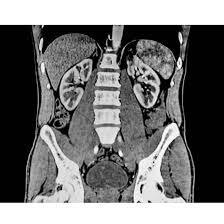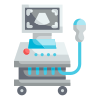Fill out form to enquire now
MRI For Upper Abdomen
Medintu has collaborated with the best pathology laboratories that are NABL and NABH certified and follow ISO safety guidelines to provide the best MRI scan for the Upper Abdomen at an affordable price for needy individuals. MRI is one of the modern types of imaging which is widely used in the diagnosis and assessment of upper abdominal disorders. Due to the use of strong magnets and radio waves, MRI offers clear pictures of soft tissues and organs like liver, pancreas, kidneys and gallbladder. This noninvasive technique is useful especially for diagnostics of diverse pathologies that may manifest with a tumorizing mass, cystic formation, or inflammatory process and gives the opportunity for significant data regarding a patient’s condition to the healthcare worker. MRI unlike other imaging modalities does not use ionizing radiation to generate images and this makes it safe for patients who need to undergo multiple imaging. This webpage is designed to become your adviser on the need, how and what to prepare for MRI, and how the upper abdomen benefits from the procedure so that you can make an informed decision the next time you have to make a decision about your health. From abdominal symptoms to regular check-ups, understanding MRI can improve your overall experience as any affected client.
To schedule an appointment for an MRI for the Upper Abdomen, simply contact Medintu or call our customer care at +919100907036 or +919100907622 for more details and queries.
What is an MRI?
The MRI is, therefore, a medical imaging technique that is used to make images of organs/tissues in the body. MRI is a technology that operates with strong magnets and radio waves in order to create images. According to this understanding, the MRT draws the hydrogen atoms in the body by dropping the magnetic field on them and through the radio waves interrupts this. And when the signal is switched off the hydrogen atoms release signals while getting back to normal position and these signals are used to build images. MRI uses high-resolution images that make it most suitable for capturing soft tissues, brain muscles and organs such as the thyroid gland. MRI is different from other techniques such as X-ray or computer tomography which utilise ionising radiation making MRI safer for many patients. MRI can be applied even to diagnose different disorders, such as tumours or flu, inflammation, and injuries. MRI is used to detect cancer, brain tumours, joint diseases, and spinal diseases. It can also be used to track the results of a disease or a treatment program.
Indications for MRI of the Upper Abdomen
An MRI of the upper abdomen is most commonly ordered for many different clinical indications. Here are some common indications:
1.Liver Disorders:
- Diagnosis of liver diseases such as liver tumor, cysts or abscess
- Evaluation of liver cirrhosis or fatty liver disease
- Diagnosis of hepatitis and other inflammatory diseases
2.Pancreatic Conditions:
- Identification of pancreatic tumor or cyst
- Assessment of the pancreatitis client may be with acute or chronic type.
- Evaluation of Complication Associated with Pancreatic Disorders
3.Biliary Tract Issues:
- Imaging of the strictures or stones in the bile duct
- Assessment of cholangitis and other biliary infections
4.Kidney Abnormalities:
- To evaluate the renal masses or cysts
- Evaluation of renal calculi or obstructions of the urinary tracts
- Assessment of renal vascular diseases
5.Gastrointestinal Disorders:
- Detection of other IBDs such as Crohn diseases, Ulcerative colitis
- Investigation of some abdominal pain of non-specific etiology
- Assessment of tumours or other pathologies in the gastrointestinal tract
6.Vascular Assessment:
- Diagnostic imaging of abdominal vessels for aneurysmal or for the purpose of diagnosing vascular malformations.
- Assessment of portal vein thrombosis or other vascular disease
Preparing for an MRI
It is important to be prepared for an MRI of the upper abdomen in order to put the imaging process to great effectiveness. Here are key steps to follow:
1.Consult Your Doctor:
- This means one should report any specific concern or symptom to his or her healthcare provider.
- Find out if MRI is the right choice of imaging for your health issue.
2.Fasting Requirements:
- Sometimes you may be advised to avoid food the entire day although normally, it is recommended that patients do not take anything at least four to six hours prior to the scan if a contrast agent will be employed. This could clearly enhance the image or prevent frustration of the user.
3.Medication Instructions:
- It is important that a doctor be advised of any medication you are currently or have been taking. And as they advised on the drugs that should be continued or avoided a day before the MRI.
4.Clothing and Accessories:
- Comfortable, loose clothing should be worn. Don’t be surprised if you are told to undress and put on a hospital gown for the scan.
- Take off all the metallic accessories such as rings, bracelets, necklaces, clips, earrings, wristwatches, hairpins, and glasses, since they hamper the images taken by MRI.
5.Health History:
- Ensure that you inform your healthcare team regarding any previous operations, allergies, especially to contrast agents and any other diseases you have.
6.Claustrophobia and Anxiety:
- However, if the patient had claustrophobia, or any other kind of anxiety, about the procedure, it had better discuss with the doctor. They may suggest ways to relax, or prescribe anti-anxiety drugs for you to take, in case of an attack.
7.Arrive Early:
Patients should plan to be at the imaging center at least thirty minutes before the appointment to fill out any forms needed and to be calm before the procedure.
The MRI Procedure
The following is a guide on what to expect during an MRI, information that will definitely go a long way in making you comfortable. Here’s a step-by-step overview of the MRI process for the upper abdomen:
1.Arrival and Check-In:
When visiting an imaging center, there are few procedures that every patient is supposed to fill, they include registration forms. The staff may ensure and confirm your details of health history and your preparation instructions.
2.Changing Clothes:
You may be given a hospital gown to wear because that will not be any metal objects on you.
3.Positioning:
MRI is a painless exam and during the procedure, most commonly, you will be positioned lying on your back on the MRI table. The technologist will bring you to a comfortable position, he or she may cover your body with cushions.
4.Coil Placement:
For the upper abdominal area, another special coil with a help of capturing images will be applied. This coil is typically implemented in order to improve image resolution.
5.Entering the MRI Machine:
The specimen table will be translated into the MRI scanner, a large cylindrical shaped machine. The rugged surface of the object causes the scanner to have difficulty receiving clear images, but one has to remain still during the process.
6.The Scanning Process:
Patients may hear tapping or thumping noise from the MRI machine once the scanning begins to take its images. You may be provided with earplugs or headphones in a bid to reduce the sound.
At some point, you will be required to take a breath some of the time during the scan. In most cases, the technologist will take you through this process.
7.Use of Contrast Agent (if needed):
In certain situations, you may be given a contrast by injecting it through a vein in your body to help make your images clearer. You might feel a short-term cold when the contrast is drawn into the vein.
8.Duration of the Scan:
Usually, the process of MRI requires half an hour to an hour and a half depending on the type of scans needed and whether the contrast agent is used.
9.Completion:
After the scanning is done, it’s possible to put on clothes and go on with other activities if there is no contrary directive.
Interpreting MRI Results
Once your MRI of the upper abdomen is done, the radiology technician will send the images for interpretation by a radiologist, a medical doctor that focuses on imaging. Here’s what to expect in the process of interpreting MRI results:
1.Image Review:
Depending on the findings of the MRI scan, the radiologist will look for any pathological changes or problems in the upper abdominal organs, liver, pancreas, kidneys and structures adherent to these organs.
2.Common Findings:
- The radiologist will look for various conditions, such as:
- Tumors (benign or malignant)
- Cysts or fluid collections
- Inflammation (for instance, pancreatitis, hepatitis)
- Increase or decrease of some vessels or vascular states
- Symptoms of liver disorder or liver cirrhosis
3.Comparison with Previous Images:
If so desired, the radiologist will compare the findings of the current MRI to any earlier imaging exams performed to evaluate abnormalities as they evolve.
4.Report Generation:
- An analysis report will be prepared that will point out all the findings made. This report typically includes:
- Any assessment of the abnormalities identified
- Suggestions as to other tests or procedures that might have to be carried out in the future
- When normal structures were encountered, a brief account was made
5.Communication of Results:
The radiologist will submit a report to your healthcare provider who will explain all the findings to you. An assistant will tell you what these results indicate in relation to your symptoms and health history.
Next Steps:
Benefits of MRI for Upper Abdomen
There are numerous benefits of MRI in the upper abdomen and this makes it a precious tool in diagnosing diseases. Here are some key benefits:
1.High-Resolution Imaging:
MRI offers very high resolution of the soft tissues and can be very useful to image organs such as the liver, the pancreas, and the kidneys.
2.Non-Invasive Procedure:
MRI is non invasive in nature; it is an imaging technique and therefore no surgical intervention is required to administer this medical technique; the risks and consequently the recovery period are therefore minimized.
3.No Ionizing Radiation:
MRI is safer for the patient than X-ray, CT scans because it uses magnetic fields and radio waves instead of ionizing radiation and is not regarded as unsafe when done often .
4.Excellent Soft Tissue Contrast:
MRI is particularly advantageous in the differential diagnosis of different soft tissues; this makes it easy to diagnose tumors, cysts as well as inflammatory states.
5.Versatility:
MRI offers the ability to study numerous pathologic conditions in the abdomen such as tumors, diseases of the liver or pancreas, pancreatitis, and vascular diseases, among others, supplying all the necessary diagnostic data.
6.Functional Imaging:
There are also scanners that look at the function of organs such as blood flow or tissue perfusion so that appraisal of the health of an organ is not only architectural but functional as well.
7.Guidance for Treatment Decisions:
MRI can provide specific information and the precise images from MRI can be used to plan a surgery or decide whether medication is required or whether to leave the tumor undisturbed.
8.Follow-Up Capability:
MRI is usually applied to track the previously diagnosed diseases over a period of time, which enables the evaluation of the treatment’s efficacy, as well as the progression of a particular disease without the use of radiation.
9.Patient Comfort:
Anxiety can be searched in an MRI machine however the procedure itself is well endured. Most of the facilities avail comfort measures such as playing music or affording relaxation strategies.
- Test Type: MRI For Upper Abdomen
- Preparation:
- Wear a loose-fitting cloth
- Fasting required
- Carry Your ID Proof
- Prescription is mandatory for patients with a doctor’s sign, stamp, with DMC/HMC number; as per PC-PNDT Act
- Reports Time: With in 3-4 hours
- Test Price: Rs.8000
How can I book an appointment for an MRI for the Upper Abdomen through Medintu?
To schedule an appointment for an MRI for the Upper Abdomen, simply contact Medintu or call our customer care at +919100907036 or +919100907622 for more details and queries.
What is an MRI?
MRI stands for Magnetic Resonance Imaging, which is a painless technique of using magnetic fields and radio waves to produce clear images of the body’s soft tissues.
Why may an MRI be needed for the upper abdomen?
MRI is used in determination of conditions involving body organs such as the liver, pancreas, and the kidneys. It is very helpful in the identification of tumours,cysts and inflammatory conditions.
What should I do before having an Upper Abdomen MRI?
You may be asked not to eat or drink for several hours before the procedure – this is especially important if a dye is to be used. It is advisable to dress casually and nonrestrictively also you should avoid wearing any metallic accessories not even jewellery.
Will I experience any pain during MRI scans?
A majority of patients who have been through MRI rarely feel aches. The coil will be gently placed over your abdomen and it can be a little uncomfortable, loud, but generally ear plugs are provided.
What is the time required for an MRI examination of the upper abdomen?
The procedure usually takes 30-60 minutes on average, although this varies depending on scans required, and whether a contrast agent is applied.
Is there any danger in MRI?
MRI is generally regarded as non-hazardous. Nevertheless, there are some contraindications to the procedure, such as the presence of some implants (for example pacemakers or cochlear implants) and metal fragments. It is always important to disclose your past medical history to your doctor.
What is a contrast agent and do I need one?
A contrast agent is a substance that helps to improve the examined body’s images. It may be given through a vein during the test. Your doctor will decide whether it is needed or not depending on your situation.
Why Choose Medintu for MRI For Upper Abdomen?
Medintu is an online medical consultant that provides home-based medical services not only in your area but also in most cities in India, including Hyderabad, Chennai, Mumbai, Kolkata, and more. We have collaborated with diagnostic centers that have the best machines and equipment to ensure you get accurate results. Medintu provides 24-hour customer service for booking the appointment of the services and guides you with instructions. Medintu also provides the best diagnostic centers at low prices. Once you receive your test results, you can easily book an appointment with our network of experienced doctors for consultation. To schedule an appointment for an MRI for the Upper Abdomen, simply contact Medintu or call our customer care at +919100907036 or +919100907622 for more details and queries.





